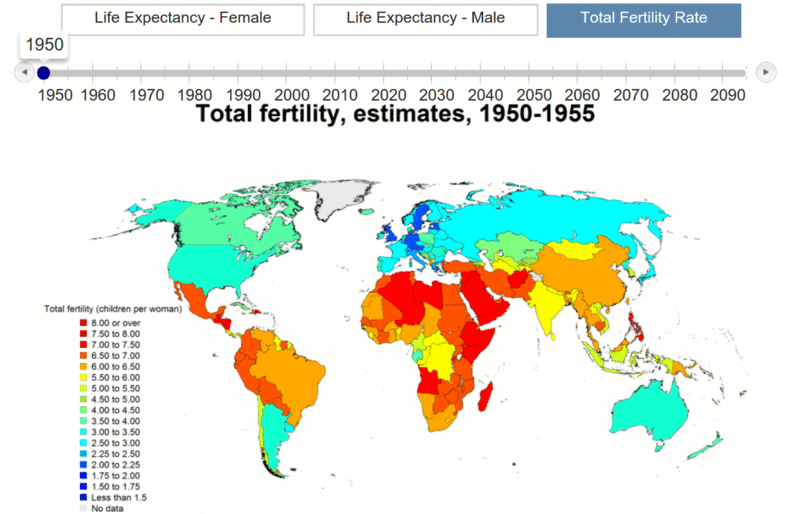Fertility rate
General Fertility Rate, or simply Fertility Rate, is the total number of live births per 1000 women of reproductive age per year.[1] In contrast, the Total Fertility Rate is a figure that represents the average number of children that a theoretical group of women would have, provided that all women lived to the end of their reproductive years and they bore a specific number of children at each age.[2]
Total fertility rate is generally considered to be a better, more direct, measure of fertility since it looks at the total number of children a single woman would have over her lifetime. It is also more representative of how population will change in a country. Closely associated with fertility rate is the idea of a population replacement rate, or the number of children each woman must have to result in population stability.[2] For 2012, estimates were that 2.1 children were needed per woman to maintain the world population.[3] Changing fertility rates are also closely linked to changes in world population, as well as urban and rural populations worldwide.[4]
Developed vs. Developing World
Fertility rates in undeveloped countries are generally much higher than those in developed countries. Wealthier countries tend to see a trend in which fertility rates were only slightly higher than the population replacement rate, at times dipping slightly below. Factors that contribute to this are low mortality rates, relative stability in society, greater wealth, more access to education (especially for women), and more urbanization. The participation of women in the labor force also lowers the fertility rate of an area.[5]
In undeveloped countries, more children are seen as a necessity. Fertility rates can reach up to five or six children in these areas. Less developed countries' projections for fertility rates into the future start off with a very high fertility rate, and are projected to see a sharp drop in the fertility rate as development occurs in these areas. Lack of access to contraceptives, high infant mortality rate, incidences of civil war, and lower levels of female education all lead to more children being born for each woman.[5]
For more information on changing fertility rates, check out the UN's World Population Prospects or The World Bank's fertility rate page.

For Further Reading
- World population
- Urban population
- Rural population
- Economy
- Gross domestic product
- Developing countries
- Access to electricity
- Or explore a random page
References
- ↑ Simcoe Muskoka Health Stats. (2015, Feb. 18). 'Total and General Fertility Rates [Online]. Available: http://www.simcoemuskokahealthstats.org/topics/pregnancy-and-before/birth-and-fertility-rates/total-general-fertility-rates
- ↑ 2.0 2.1 Central Intelligence Agency. (2015, Feb. 16). The World Factbook [Online]. Available: https://www.cia.gov/library/publications/the-world-factbook/docs/notesanddefs.html?countryName=France&countryCode=fr®ionCode=eu#2127
- ↑ Leontine Alkema. (2015, Feb. 18). Probabilistic Projections of the Total Fertility Rate [Online]. Available: http://esa.un.org/unpd/wpp/Documentation/pdf/Alkema_Fertility.pdf
- ↑ UN Population Division. (2015, Feb. 17). World Urbanization Prospects (2014 Revision) [Online]. Available: http://esa.un.org/unpd/wup/Country-Profiles/
- ↑ 5.0 5.1 Robert L. Brown et al. (2015, Feb. 17). Some Causes of Fertility Rates Movements [Online]. Available: https://uwaterloo.ca/waterloo-research-institute-in-insurance-securities-and-quantitative-finance/sites/ca.waterloo-research-institute-in-insurance-securities-and-quantitative-finance/files/uploads/files/03-02.pdf
- ↑ This image was taken from wikimedia's image repository, accessed July 17th, 2018. https://en.wikipedia.org/wiki/File:Total_Fertility_Rate,_1950_-_2100,_World_Population_Prospects_2015,_United_Nations.gif. The data comes from the United Nations, Department of Economic and Social Affairs, Population Division. For more information please see here.

